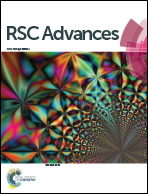Pd-catalyzed tandem homocoupling–aldol–dehydration of ortho-acylphenyl iodides†
Abstract
A Pd-catalyzed cascade Ullmann coupling–aldol–dehydration reaction of ortho-acylphenyl iodides has been explored. This transformation provides a concise access to colchino analogues in moderate to good yields with wide functional group tolerance.


 Please wait while we load your content...
Please wait while we load your content...